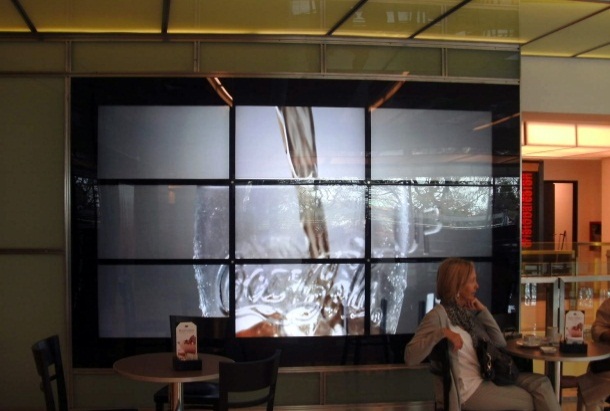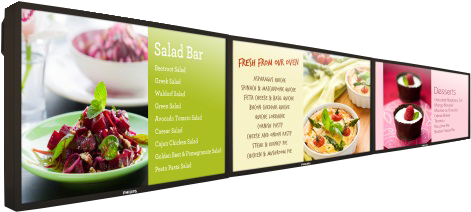Professional Displays
About ENERGY STAR Professional Displays
 Offering all the features and functionality of standard models, ENERGY STAR certified professional displays, also known as digital signage or commercial displays, come with more efficient and cooler-running panel technologies that can save you money.
Offering all the features and functionality of standard models, ENERGY STAR certified professional displays, also known as digital signage or commercial displays, come with more efficient and cooler-running panel technologies that can save you money.
- For a 3 x 3 video wall of 40-inch professional displays, choosing ENERGY STAR can save close to $2,000 in energy costs.
- For a single large display (50 - 60 inches), an ENERGY STAR certified model can save around $350.
Most professional displays are covered under the ENERGY STAR Displays specification. However, if the professional display includes a tuner or DAM (for hospitality TVs), it is covered by the more stringent ENERGY STAR Televisions specification.1
Who uses professional displays?
 Professional displays are generally used by Fortune 500 companies (e.g., conference rooms, digital signage in lobbies), airports (e.g., flight information monitors), restaurants (e.g., menu boards), and retail (e.g., outdoor advertising, video walls), and higher education. According to the a 2012 CompTIA survey, one in three retailers currently use displays, with an additional 20 percent intending to do so soon.
Professional displays are generally used by Fortune 500 companies (e.g., conference rooms, digital signage in lobbies), airports (e.g., flight information monitors), restaurants (e.g., menu boards), and retail (e.g., outdoor advertising, video walls), and higher education. According to the a 2012 CompTIA survey, one in three retailers currently use displays, with an additional 20 percent intending to do so soon.
____________________________
1 The ENERGY STAR display specification -- which addresses computer monitors, digital picture frames and professional displays -- limits Off mode, Sleep mode (based on connectivity capabilities) and On Mode power (based on screen size and features). The ENERGY STAR television specification – which addresses hospitality TVs, professional displays with tuners: 1) Limits Standby-Passive mode (less than or equal to 1 watt and On mode (based on screen size) power; 2) Sets luminance and DAM requirements; and 3) Limits total energy use of hospitality TVs.
Current Specification Effective Date: June 1, 2013
ENERGY STAR certified professional displays meet stringent energy efficiency requirements in On, Sleep, and Off Modes. For small professional displays less 30 inches in diagonal screen size, the on mode power consumption limits are based on both viewable screen area and resolution. The on mode power consumption limits for large professional displays (31 inches to 61 inches) is based on viewable screen area alone.
Manufacturers sell two kinds of professional displays that tend to differ in lifespan, features, panel type, and connectivity. It is important to take these differences into account when choosing a display to ensure it meets your specific needs.
- Some professional displays have a lifespan of around 50,000 hours and use the same panel type as a consumer television but add features such as:
- Locking of front panel and IR remote
- Download acquisition mode (DAM) for hospitality TVs
- Portrait orientation
- PC compatibility2
- Expanded connectivity options such as PC inputs, USB, serial ports, RS-232, and VGA inputs in addition to RCA and cable inputs3
- Tougher enclosures (e.g., to withstand the high heat and grease of menu boards)4
- The other type of professional display is designed for 24/7 use and may have a lifespan of up to 100,000 hours. Generally more costly, these professional displays may be brighter, have better contrast ratios5, cool quicker and come with heavy duty power supplies and metal housings. They also can come with additional features such as:
- Video wall compatible
- Touch screens
- Enterprise management capability
- Ceiling mounting
- Ability to host computers/graphics cards
- Advanced anti burn-in & image-retention features6
- Tempered glass face7
When developing your digital messaging, please consider the following:8
- Have A Plan For Your Digital Signs. Establish what content they are going to display on their screens and how it will helps your business. Some metrics are more obvious, such as featuring items on a digital menu board but others can be a bit harder to determine, such as corporate communication in offices or informational screens in a waiting room. Make sure you spend the time to identify the business needs that you have and how your signage can meet them.
- Choose the Right Displays Platform. Look at the type of content you want to show. Are you looking to do a simple playlist of videos or a mixture of images, videos and dynamic data? Different platforms excel at different approaches. Once you have the content questions answered, you can then start to determine the hardware and software that is best for playing back that content. The most important thing is that you look at the content management tools before buying.
- Understand Your Costs. The biggest hidden cost that is often overlooked is the cost of creation and updating content. A single design can easily cost several thousand dollars. Once this design is on your display, how is it changed? If you need to call a designer every time you want to make a minor change it can amount to some significant fees. Even worse is when the content on the screens isn't current and your digital signs are rendered useless.
_____________________
2 www.ezdigisign.com/commercialvsconsumer.html
3 www.jcoproducts.com/swf/Top 5 reasons to buy commercial grade screens for digital signage.pdf
4 www.jcoproducts.com/swf/Top 5 reasons to buy commercial grade screens for digital signage.pdf
5 www.allsee-tech.com/news/digital-signage-why-use-commercial-displays.html
6 www.ezdigisign.com/commercialvsconsumer.html
7 www.allsee-tech.com/news/digital-signage-why-use-commercial-displays.html
8 www.smartersign.com/articles/digital-signage-mistakes












